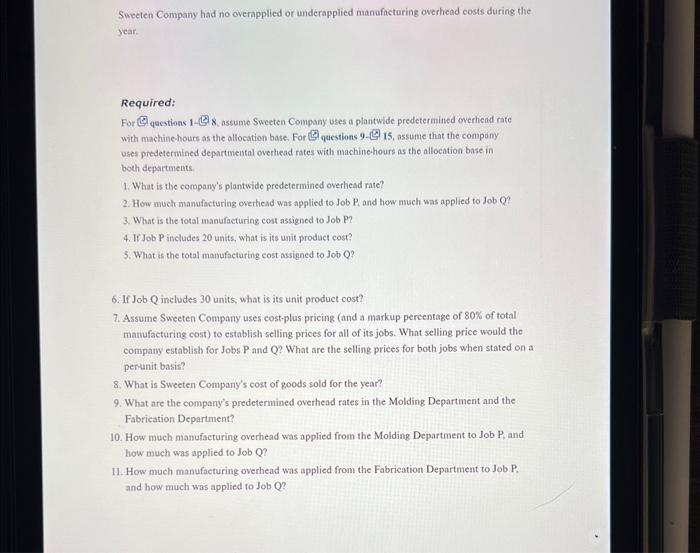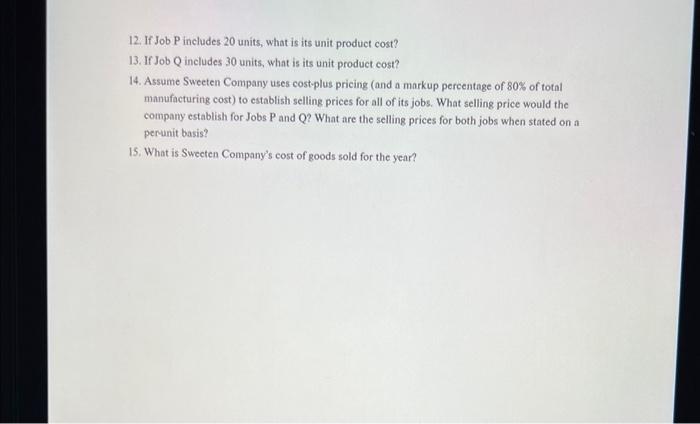Sweeten Company had no jobs in progress at the beginning of the year and no beginning inventories. It started, completed, and sold only two jobs during the year-Job P and Job Q. The company uses a plantwide predetermined overhend rate based on machine-hours. At the beginning of the year, it estimated 4,000 machine-hours would be required for the period's estimated level of production. Sweeten also estimated $25,000 of fixed manufncturing overhead cost for the coming period and variable manufacturing overhead of \$1.70 per machine-hour. Becaute Sweeten has two manufocturing departments-Molding and Fabrication-it is considering replacing its plantwide overtiead rate with departatental rates that would also be based on machinehours. The company gathered the following additional information to enable calculatiog departmental overhead rates: The direct materials cost, direct labor cost, and machine-hours used for Jobs P and Q are as follows: Sweeten Company had no overapplied or underapplied manufncturing overhead costs during the year. Required: For questions 1-(8) assume Sweeten Company uses a plantwide predetermined overhead rate with machine-hours as the allocation base. For GSi questions 9 -( 15, assume that the company uses predetermined departmental overhead rates with machinchours as the allocation base in both departmeats. 1. What is the company's plantwide predetermined overhead rate? 2. How much manufacturing overhead was applied to Job P. and how nuch was applied to Job Q? 3. What is the total manufacturing cost assigned to Job P ? 4. If Job P includes 20 units, what is its unit product cost? 5. What is the total masufacturing cost assigned to Job Q? 6. If Job Q includes 30 units, what is its unit product cost? 7. Assume Sweeten Company uses cost.plus pricing (and a markup pereentage of 80% of total manufacturing cost) to establish selling prices for all of its jobs. What selling price would the company establish for Jobs P and Q ? What are the selling prices for both jobs when stated on a perunit basis? 8. What is Sweeten Company's cost of goods sold for the year? 9. What are the company's predetermined overhead rates in the Molding Department and the Fabrication Department? 10. How much manufacturing overhead was applied from the Molding Department to Job P, and how much was applied to Job Q? 11. How much manufacturing overhead was applied from the Fabrication Department to Job P. and how much was applied to Job Q? 12. If Job P includes 20 units, what is its unit product cost? 13. If Job Q includes 30 units, what is its unit product cost? 14. Assume Sweeten Company uses cost-plus pricing (and a markup percentage of 80% of total manufacturing cost) to establish selling prices for all of its jobs. What selling price would the company establish for Jobs P and Q ? What are the selling prices for both jobs when stated on a perunit basis? 15. What is Sweeten Company's cost of goods sold for the year? Sweeten Company had no jobs in progress at the beginning of the year and no beginning inventories. It started, completed, and sold only two jobs during the year-Job P and Job Q. The company uses a plantwide predetermined overhend rate based on machine-hours. At the beginning of the year, it estimated 4,000 machine-hours would be required for the period's estimated level of production. Sweeten also estimated $25,000 of fixed manufncturing overhead cost for the coming period and variable manufacturing overhead of \$1.70 per machine-hour. Becaute Sweeten has two manufocturing departments-Molding and Fabrication-it is considering replacing its plantwide overtiead rate with departatental rates that would also be based on machinehours. The company gathered the following additional information to enable calculatiog departmental overhead rates: The direct materials cost, direct labor cost, and machine-hours used for Jobs P and Q are as follows: Sweeten Company had no overapplied or underapplied manufncturing overhead costs during the year. Required: For questions 1-(8) assume Sweeten Company uses a plantwide predetermined overhead rate with machine-hours as the allocation base. For GSi questions 9 -( 15, assume that the company uses predetermined departmental overhead rates with machinchours as the allocation base in both departmeats. 1. What is the company's plantwide predetermined overhead rate? 2. How much manufacturing overhead was applied to Job P. and how nuch was applied to Job Q? 3. What is the total manufacturing cost assigned to Job P ? 4. If Job P includes 20 units, what is its unit product cost? 5. What is the total masufacturing cost assigned to Job Q? 6. If Job Q includes 30 units, what is its unit product cost? 7. Assume Sweeten Company uses cost.plus pricing (and a markup pereentage of 80% of total manufacturing cost) to establish selling prices for all of its jobs. What selling price would the company establish for Jobs P and Q ? What are the selling prices for both jobs when stated on a perunit basis? 8. What is Sweeten Company's cost of goods sold for the year? 9. What are the company's predetermined overhead rates in the Molding Department and the Fabrication Department? 10. How much manufacturing overhead was applied from the Molding Department to Job P, and how much was applied to Job Q? 11. How much manufacturing overhead was applied from the Fabrication Department to Job P. and how much was applied to Job Q? 12. If Job P includes 20 units, what is its unit product cost? 13. If Job Q includes 30 units, what is its unit product cost? 14. Assume Sweeten Company uses cost-plus pricing (and a markup percentage of 80% of total manufacturing cost) to establish selling prices for all of its jobs. What selling price would the company establish for Jobs P and Q ? What are the selling prices for both jobs when stated on a perunit basis? 15. What is Sweeten Company's cost of goods sold for the year









